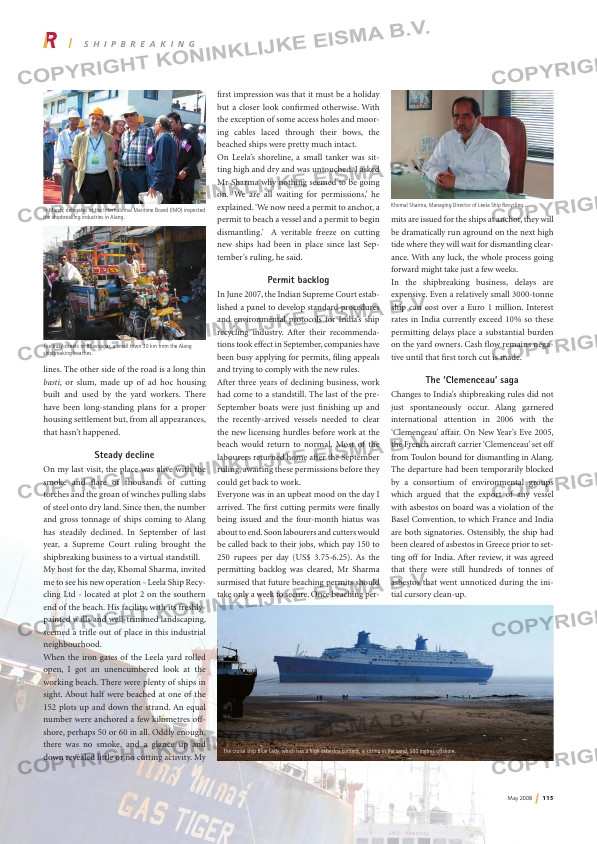Page 115 from: May 2008

May 2008 115
S H I P B R E A K I N G
lines. The other side of the road is a long thin
basti, or slum, made up of ad hoc housing
built and used by the yard workers. There
have been long-standing plans for a proper
housing settlement but, from all appearances,
that hasn’t happened.
Steady decline
On my last visit, the place was alive with the
smoke and fl are of thousands of cutting
torches and the groan of winches pulling slabs
of steel onto dry land. Since then, the number
and gross tonnage of ships coming to Alang
has steadily declined. In September of last
year, a Supreme Court ruling brought the
shipbreaking business to a virtual standstill.
My host for the day, Khomal Sharma, invited
me to see his new operation – Leela Ship Recy-
cling Ltd – located at plot 2 on the southern
end of the beach. His facility, with its freshly-
painted walls and well-trimmed landscaping,
seemed a trifl e out of place in this industrial
neighbourhood.
When the iron gates of the Leela yard rolled
open, I got an unencumbered look at the
working beach. There were plenty of ships in
sight. About half were beached at one of the
152 plots up and down the strand. An equal
number were anchored a few kilometres off-
shore, perhaps 50 or 60 in all. Oddly enough,
there was no smoke, and a glance up and
down revealed little or no cutting activity. My
fi rst impression was that it must be a holiday
but a closer look confi rmed otherwise. With
the exception of some access holes and moor-
ing cables laced through their bows, the
beached ships were pretty much intact.
On Leela’s shoreline, a small tanker was sit-
ting high and dry and was untouched. I asked
Mr Sharma why nothing seemed to be going
on. ‘We are all waiting for permissions,’ he
explained. ‘We now need a permit to anchor, a
permit to beach a vessel and a permit to begin
dismantling.’ A veritable freeze on cutting
new ships had been in place since last Sep-
tember’s ruling, he said.
Permit backlog
In June 2007, the Indian Supreme Court estab-
lished a panel to develop standard procedures
and environmental protocols for India’s ship
recycling industry. After their recommenda-
tions took effect in September, companies have
been busy applying for permits, fi ling appeals
and trying to comply with the new rules.
After three years of declining business, work
had come to a standstill. The last of the pre-
September boats were just fi nishing up and
the recently-arrived vessels needed to clear
the new licensing hurdles before work at the
beach would return to normal. Most of the
labourers returned home after the September
ruling, awaiting these permissions before they
could get back to work.
Everyone was in an upbeat mood on the day I
arrived. The fi rst cutting permits were fi nally
being issued and the four-month hiatus was
about to end. Soon labourers and cutters would
be called back to their jobs, which pay 150 to
250 rupees per day (US$ 3.75-6.25). As the
permitting backlog was cleared, Mr Sharma
surmised that future beaching permits should
take only a week to secure. Once beaching per-
mits are issued for the ships at anchor, they will
be dramatically run aground on the next high
tide where they will wait for dismantling clear-
ance. With any luck, the whole process going
forward might take just a few weeks.
In the shipbreaking business, delays are
expensive. Even a relatively small 3000-tonne
ship can cost over a Euro 1 million. Interest
rates in India currently exceed 10% so these
permitting delays place a substantial burden
on the yard owners. Cash fl ow remains nega-
tive until that fi rst torch cut is made.
The ‘Clemenceau’ saga
Changes to India’s shipbreaking rules did not
just spontaneously occur. Alang garnered
international attention in 2006 with the
‘Clemenceau’ affair. On New Year’s Eve 2005,
the French aircraft carrier ‘Clemenceau’ set off
from Toulon bound for dismantling in Alang.
The departure had been temporarily blocked
by a consortium of environmental groups
which argued that the export of any vessel
with asbestos on board was a violation of the
Basel Convention, to which France and India
are both signatories. Ostensibly, the ship had
been cleared of asbestos in Greece prior to set-
ting off for India. After review, it was agreed
that there were still hundreds of tonnes of
asbestos that went unnoticed during the ini-
tial cursory clean-up.
Khomal Sharma, Managing Director of Leela Ship Recycling.
In March, delegates of the International Maritime Board (IMO) inspected
the shipbreaking industries in Alang.
The busy streets of Bhavnagar, a small town 30 km from the Alang
shipbreaking beaches.
The cruise ship Blue Lady, which has a high asbestos content, is sitting in the sand, 500 metres offshore.
RI_023_Shipbreaking.indd 4 14-05-2008 13:53:45



